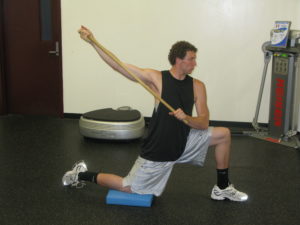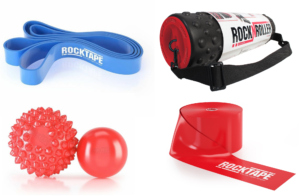by Mitch Hauschildt, MA, ATC, CSCS
I talk a lot about the need for mobility to ensure high quality movement patterns. As Gray Cook says, “If we aren’t mobile, we will never be stable.” I agree completely, thus from a corrective exercise perspective, we must correct mobility issues immediately when we find them. One recurrent thing that I find when traveling and speaking with clinicians and fitness professionals all over the country is that their mobility interventions don’t seem to be working very well. My opinion on why they aren’t working comes down to a lack of understanding what flexibility and mobility really are.
Simply put, flexibility is a nervous system response.
The traditional concept of actin-myosin cross bridging relaxing and allowing the muscle to move further just isn’t supported in the research. What we have learned over the years is that when we move further through a range of motion, we have actually convinced the nervous system to allow us to move further. That is what flexibility training is all about.
Because of this, statically holding stretches just doesn’t make a lot of sense. Especially if the stretch is a mild stretch where little to no discomfort is felt. It doesn’t stimulate the brain enough to make any meaningful changes to tone. I think most of us have prescribed home programs with stretches that never seem to do anything which frustrates both us and our patient/client.
It’s easy to say that the brain controls it all, but sometimes it’s hard to really understand. So, let’s unpack it a little bit:
When someone is “tight,” it is because their nervous system is more sensitive to a stretching sensation than someone who isn’t as “tight.” To put things simply, when the muscle feels a stretch, the natural reaction of the muscle spindles is to contract (stretch reflex). When the muscle spindles turn on, the muscle contracts and shortens. This is what limits motion. The idea that flexibility is a nervous system response can be demonstrated in a number of ways:
- Anyone who has been in a cadaver lab can attest to the fact that muscle all looks the same. At it’s foundation, muscle doesn’t have a lot of variance between individuals. There is some variation in the make up of different muscles throughout the body, but from person to person, it isn’t that much different. Thus, after people die and their brain no longer controls their movements, their extensibility of their muscles becomes fairly standard from person to person.
- We see immediate impacts in flexibility after things like foam rolling, massage, IASTM, kinesiology tape and so on. These interventions aren’t trying to make muscles longer by stretching them, yet they do allow us to move further when we retest our movement assessments. This is because all of these strategies are designed to affect neural tone, not the mechanical make up of the muscle.
- Research has shown for years that PNF stretching is effective for improving range of motion. Through the series of contract-relax-hold variations, the reason that PNF stretching works is because sooner or later, the nervous system gets tired of resisting all of those variables and it shuts off and goes away. That’s when we see an increase in range of motion.
- Research indicates that stretching is more effective when it is taken to the point of discomfort. It shouldn’t be truly painful, but if it isn’t uncomfortable, it won’t stimulate change in the nervous system.
- Research shows that flexibility gains are made more easily post workout. We like to explain this phenomenon with things like increased tissue temperature, blood flow, and so on, but the reality is that flexibility gains are made more effectively post workout because the nervous system is fatigued and is easily overloaded.
- Research also demonstrates that performing static stretching prior to speed and power sports causes a decrease in performance. This is due to the fact that static stretching tells the nervous system to go away and shut down. I don’t want that prior to my athlete’s competition. I want their nervous system to be stimulated and ready to go. That’s why the performance community has largely moved away from stretching before activity.
Stretch Tolerance
Stretch tolerance is a much better term than flexibility. Muscles that are “flexible” are simply more tolerant of a stretching sensation than those that aren’t flexible. When the body feels a stretch, a more flexible person doesn’t sense the stretch nearly as much because their brain and nervous system aren’t as sensitive to it.
If we can accept that flexibility and mobility are largely a nervous system response, then we have to re-examine our range of motion interventions.
Static stretching alone rarely improves range of motion. We must combine manual therapies, stretching and neurological repatterning to make significant improvements in mobility. I use a 3 step process to improve mobility:
 Improve Tissue Quality: This can occur in a number of different ways. You can foam roll, perform IASTM, manual massage, positional release therapy, or whatever your favorite manual technique is. The point is to utilize Robert Schleip’s model of reflexive activation, which states that when we touch the skin, we stimulate the mechanoreceptors in the fascial layers, which leads to an eventual palpable response in the tissue. As a general rule, if we are looking to improve mobility, it usually makes sense to stimulate the Ruffini endings with slow, deep, sustained pressure, but that approach also depends on what other things are found in your evaluation.
Improve Tissue Quality: This can occur in a number of different ways. You can foam roll, perform IASTM, manual massage, positional release therapy, or whatever your favorite manual technique is. The point is to utilize Robert Schleip’s model of reflexive activation, which states that when we touch the skin, we stimulate the mechanoreceptors in the fascial layers, which leads to an eventual palpable response in the tissue. As a general rule, if we are looking to improve mobility, it usually makes sense to stimulate the Ruffini endings with slow, deep, sustained pressure, but that approach also depends on what other things are found in your evaluation.- Perform Cyclic Stretching: Cyclic stretching is stretching a muscle, but doing it in short bouts for a high number of reps. We typically perform 10-20 reps per area, holding each stretch 3-5 seconds as part of our cyclic stretching routines. It is a series of on and off movements over and over. This approach will effectively send an overload signal to the brain to desensitize it. In my experience, patients and clients tend to be more compliant with this form of stretching than 30-60 second holds because they are more mentally engaging. If you are looking to improve the effectiveness of this approach, consider adding reciprocal inhibition as well. When you contract one muscle, it will force the opposing muscle group to relax and the stronger the contraction, the greater the relaxation. This will ensure that the target muscle will be fully relaxed, which will allow you to maximize the neurological gains. Further, reciprocal inhibition typically ensures joint centration as well, which is always good for improving movement.
- Neurological Repatterning: Once the soft tissue work is done and the mobility gains are made via stretching, it is imperative that you perform exercise and stability work to lock in the change. As a simple explanation, if the brain doesn’t recognize the new range of motion that you just gained, it will loose it very quickly. Just because you make mobility gains does not ensure that your brain will reset motor control and utilize the new, larger range. Not locking in mobility gains with exercise is a common mistake and the reason that I believe that many flexibility programs fail. They get what they want, but then lose it quickly.
Taking this 3 step approach will take your mobility training to the next level. Make sure that your screen or assessment tools are effective at pinpointing when a mobility issue is truly and mobility issue and not a stability problem. Mobility and Stability are tightly connected and we need to understand what is what and when each need to be addressed. When you identify a true mobility problem, address the brain and nervous system to maximize your outcomes.


Great blog Mitch. Thanks for giving me more ammo and another way to explain why static stretching is crap to our bodies and it dosent just stop after the stretch.
Question: How do we get someone who is super flexible to be less flexible?
You have to create more stability. If they are very flexible, its because have low tone and need more stability and motor control. Get them strong and stable.
Thanks. That is what I figured.
What’s your favorite movement assessment tools? I look a lot at squats and functional reach tests. Any others that are highly used?